In recent years, autonomous agents based on large language models (LLMs) have continuously evolved in architecture, memory, perception, reasoning, and action, demonstrating the potential to redefine possibilities across multiple fields.
Author: Rituals
Translation: Blockchain in Plain Language

In recent years, the concept of agents has increasingly gained importance across various fields such as philosophy, gaming, and artificial intelligence. Traditionally, an agent refers to an entity that can act autonomously, make choices, and possess intentionality, traits typically associated with humans.
In the field of artificial intelligence, the connotation of agents has become more complex. With the emergence of autonomous agents, these agents can observe, learn, and act independently in their environment, giving concrete form to the previously abstract concept of agents in computational systems. These agents require minimal human intervention, exhibiting a capability that, while not conscious, possesses computational intent, allowing them to make decisions, learn from experience, and interact with other agents or humans in increasingly complex ways.
This article will explore the emerging field of autonomous agents, particularly those based on large language models (LLM) and their impact across various domains such as gaming, governance, science, and robotics. Building on the basic principles of agents, this article will analyze the architecture and applications of AI agents. Through this categorical perspective, we can gain deeper insights into how these agents perform tasks, process information, and continuously evolve within their specific operational frameworks.
The goals of this article include the following two aspects:
Provide a systematic overview of AI agents and their architectural foundations, focusing on components such as memory, perception, reasoning, and planning.
Explore the latest trends in AI agent research, highlighting application cases that redefine possibilities.
Note: Due to the length of the article, this translation has been abridged from the original text.
1. Trends in Agent Research
The development of agents based on large language models (LLMs) marks a significant advancement in AI research, encompassing multiple progressions from symbolic reasoning, reactive systems, reinforcement learning to adaptive learning.
Symbolic Agents: Simulate human reasoning through rules and structured knowledge, suitable for specific problems (e.g., medical diagnosis), but struggle in complex, uncertain environments.
Reactive Agents: Quickly respond to the environment through a "perception-action" loop, suitable for fast interaction scenarios, but unable to complete complex tasks.
Reinforcement Learning Agents: Optimize behavior through trial and error learning, widely used in gaming and robotics, but have long training times, low sample efficiency, and poor stability.
LLM-based Agents: LLM agents combine symbolic reasoning, feedback, and adaptive learning, possessing few-shot and zero-shot learning capabilities, widely applied in software development, scientific research, etc., suitable for dynamic environments and capable of collaborating with other agents.
2. Agent Architecture
Modern agent architectures consist of multiple modules, forming an integrated system.
1) Profile Module
The Profile Module determines agent behavior by assigning roles or personalities to ensure consistency, suitable for scenarios requiring stable personalities. The profiles of LLM agents are divided into three categories: demographic roles, virtual roles, and personalized roles.
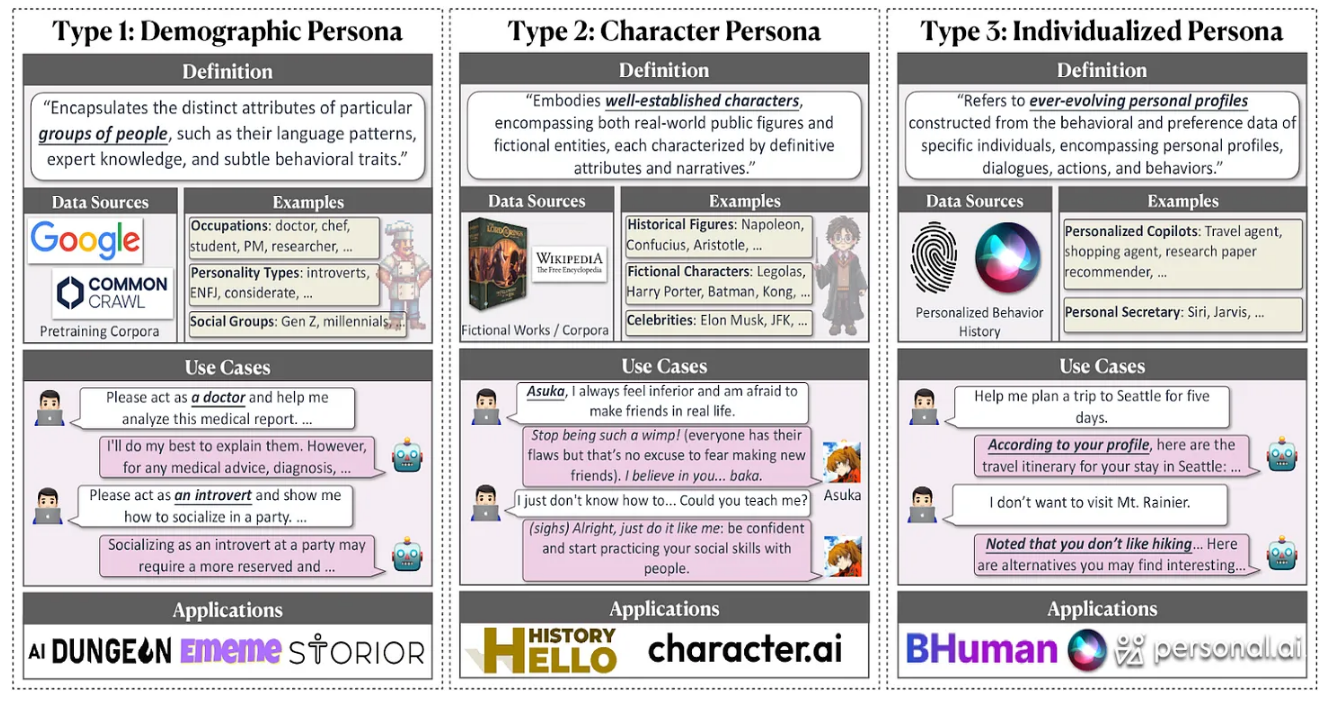
Excerpt from the paper "From Role to Personalization"
Role Enhancements to Performance: Role settings can significantly enhance the performance and reasoning capabilities of agents. For example, LLMs respond more deeply and contextually when acting as experts. In multi-agent systems, role matching promotes collaboration, improving task completion rates and interaction quality.
Profile Creation Methods: LLM agent profiles can be constructed in the following ways:
Manual Design: Manually setting role characteristics.
LLM Generation: Automatically expanding role settings through LLM.
Dataset Alignment: Constructing based on real datasets to enhance interaction authenticity.
2) Memory Module
Memory is the core of LLM agents, supporting adaptive planning and decision-making. Memory structures simulate human processes and are mainly divided into two categories:
Unified Memory: Short-term memory that processes recent information. Optimized through text extraction, memory summarization, and modified attention mechanisms, but limited by context windows.
Hybrid Memory: Combines short-term and long-term memory, with long-term memory stored in external databases for efficient recall.
Memory Formats: Common memory storage formats include:
Natural Language: Flexible and semantically rich.
Embedding Vectors: Facilitates quick retrieval.
Databases: Supports queries through structured storage.
Structured Lists: Organized in lists or hierarchical forms.
Memory Operations: Agents interact with memory through the following operations:
Memory Reading: Retrieving relevant information to support informed decision-making.
Memory Writing: Storing new information to avoid repetition and overflow.
Memory Reflection: Summarizing experiences to enhance abstract reasoning capabilities.
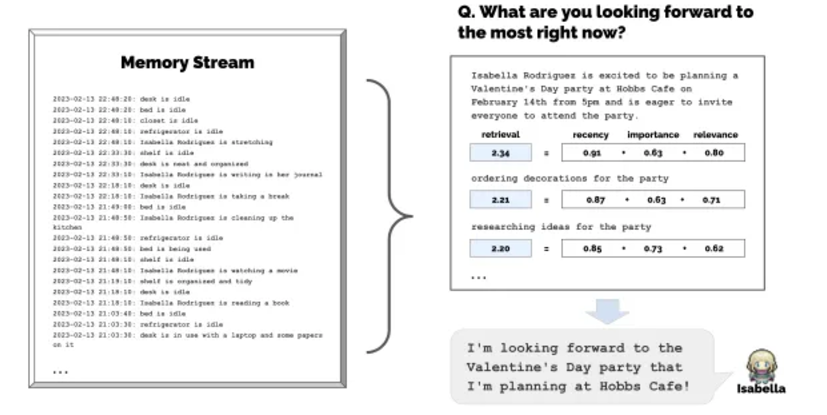
Based on the content of the paper "Generative Agents"
Research Significance and Challenges
Although memory systems enhance agent capabilities, they also present research challenges:
Scalability and Efficiency: Memory systems need to support large amounts of information and ensure quick retrieval; optimizing long-term memory retrieval remains a research focus.
Handling Context Limitations: Current LLMs are limited by context windows, making it difficult to manage large memories; research is exploring dynamic attention mechanisms and summarization techniques to expand memory processing capabilities.
Bias and Drift in Long-term Memory: Memory may contain biases, leading to prioritized processing of information and memory drift, necessitating regular updates and corrections to maintain agent balance.
Catastrophic Forgetting: New data can overwrite old data, leading to the loss of key information; techniques such as experience replay and memory consolidation are needed to reinforce critical memories.
3) Perceptual Abilities
LLM agents enhance their understanding and decision-making capabilities regarding the environment by processing diverse data sources, similar to how humans rely on sensory input. Multimodal perception integrates text, visual, and auditory inputs, enhancing the agent's ability to perform complex tasks. The following are the main input types and their applications:
Text Input: Text is the primary communication method for LLM agents. Although agents possess advanced language capabilities, understanding the implicit meanings behind instructions remains a challenge.
Implicit Understanding: Adjusting preferences through reinforcement learning to handle ambiguous instructions and infer intentions.
Zero-shot and Few-shot Capabilities: Responding to new tasks without additional training, suitable for diverse interaction scenarios.
Visual Input: Visual perception allows agents to understand object and spatial relationships.
Image-to-Text: Generating textual descriptions to help process visual data, though details may be lost.
Transformer-based Encoding: Such as Vision Transformers that convert images into text-compatible tokens.
Bridging Tools: Tools like BLIP-2 and Flamingo optimize the connection between visual and textual data using intermediate layers.
Auditory Input: Auditory perception enables agents to recognize sounds and speech, especially important in interactive and high-risk scenarios.
Speech Recognition and Synthesis: Such as Whisper (speech-to-text) and FastSpeech (text-to-speech).
Spectrogram Processing: Processing audio spectrograms as images to enhance auditory signal analysis capabilities.
Research Challenges and Considerations in Multimodal Perception:
Data Alignment and Integration: Multimodal data requires efficient alignment to avoid perception and response errors; research focuses on optimizing multimodal Transformers and cross-attention layers.
Scalability and Efficiency: Multimodal processing demands are high, especially when handling high-resolution images and audio; developing low-resource-consuming and scalable models is key.
Catastrophic Forgetting: Multimodal agents face catastrophic forgetting, requiring strategies such as prioritized replay and continual learning to effectively retain key information.
Context-Sensitive Response Generation: Prioritizing sensory data to generate responses based on context remains a research focus, particularly in noisy or visually dominant environments.
4) Reasoning and Planning
The reasoning and planning module helps agents efficiently solve problems by decomposing complex tasks. Similar to humans, it can formulate structured plans, either constructing a complete plan in advance or adjusting strategies in real-time based on feedback. Planning methods are categorized by feedback type:
Some agents construct complete plans in advance and execute them along a single path or multiple options without modifying the plan.
Other agents adjust strategies in real-time based on feedback in dynamic environments.
Planning without Feedback: In the absence of feedback, agents formulate complete plans from the start and execute them without adjustments. This includes single-path planning (executing step by step) and multi-path planning (simultaneously exploring multiple options to choose the best path).
Single-path Reasoning: Tasks are decomposed into sequential steps, with each step following the next:
Chain of Thought (CoT): By providing a few examples, agents are guided to solve problems step by step, enhancing the quality of model outputs.
Zero-shot CoT: Reasoning through the prompt "think step by step" without preset examples, suitable for zero-shot learning.
Re-prompting: Automatically discovering effective CoT prompts without manual input.
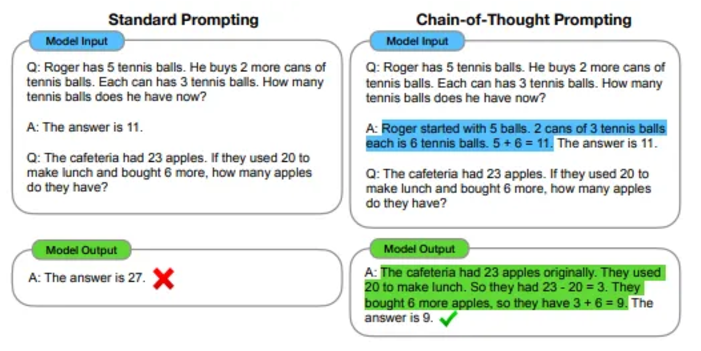
From the CoT paper
5) Multi-path Reasoning
Unlike single-path reasoning, multi-path reasoning allows agents to explore multiple steps simultaneously, generating and evaluating multiple potential solutions to select the best path, suitable for complex problems, especially in cases with various possible routes.
Example:
Self-consistency Chain of Thought (CoT-SC): Sampling multiple reasoning paths from CoT prompt outputs and selecting the most frequent steps to achieve "self-ensemble."
Tree of Thought (ToT): Storing logical steps as a tree structure, evaluating each "thought" for its contribution to the solution, using breadth-first or depth-first search for navigation.
Graph of Thought (GoT): Extending ToT into a graph structure, with thoughts as vertices and dependencies as edges, allowing for more flexible reasoning.
Reasoning through Planning (RAP): Using Monte Carlo Tree Search (MCTS) to simulate multiple plans, where the language model constructs the reasoning tree and provides feedback.
6) External Planners
When LLMs face planning challenges in specific domains, external planners provide support, integrating expertise that LLMs lack.
LLM + P: Transforming tasks into Planning Domain Definition Language (PDDL) and solving them through external planners, assisting LLMs in completing complex tasks.
CO-LLM: Models collaborate to generate text by alternately selecting model-generated tokens, allowing optimal collaboration patterns to emerge naturally.
Feedback-based Planning: Feedback-based planning enables agents to adjust tasks in real-time based on environmental changes, adapting to unpredictable or complex scenarios.
Environmental Feedback: Agents interact with the environment and adjust plans based on real-time feedback, maintaining task progress.
ReAct: Combining reasoning and action prompts to create adjustable plans during interactions.
DEPS: Revising plans in task planning to address unfinished sub-goals.
SayPlan: Refining strategies using scene graphs and state transitions to enhance situational awareness.

From the "ReAct" paper
7) Human Feedback
Interacting with humans helps agents align with human values and avoid errors. Example:
Inner Monologue: Integrating human feedback into agent planning to ensure actions align with human expectations.
Model Feedback: Feedback from pre-trained models helps agents self-check and optimize reasoning and actions. Example:
SelfCheck: A zero-shot step-by-step checker for self-identifying errors in reasoning chains and assessing correctness.
Reflexion: Agents reflect by recording feedback signals, promoting long-term learning and error correction.
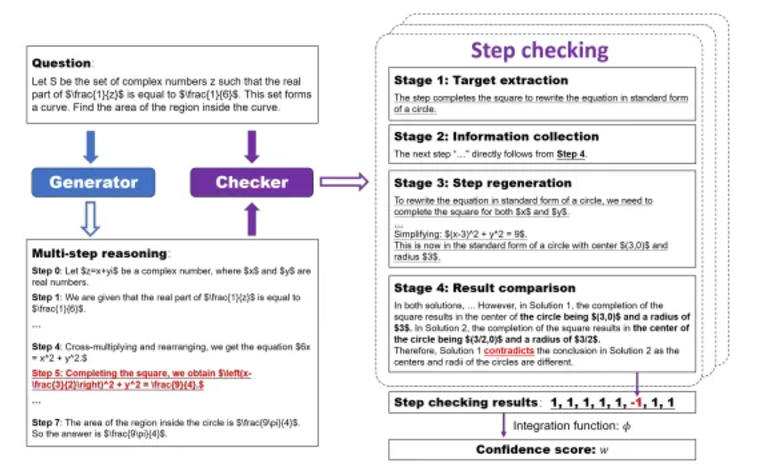
From the "SelfCheck" paper
Challenges and Research Directions in Reasoning and Planning: Although the reasoning and planning module enhances agent functionality, it still faces challenges:
Scalability and Computational Demands: Complex methods like ToT or RAP require substantial computational resources, and improving efficiency remains a research focus.
Complexity of Feedback Integration: Effectively integrating multi-source feedback to avoid information overload is key to enhancing adaptability without sacrificing performance.
Bias in Decision-Making: Prioritizing certain feedback sources or paths may lead to bias; combining bias elimination techniques is crucial for balanced planning.
8) Action
The action module is the final stage of the agent's decision-making process, including:
Action Goals: Agents execute various goals, such as task completion, communication, or environmental exploration.
Action Generation: Generating actions through recall or planning, such as memory-based or plan-based actions.
Action Space: Includes intrinsic knowledge and external tools, such as APIs, databases, or external models to execute tasks. For example, tools like HuggingGPT and ToolFormer utilize external models or APIs for task execution.
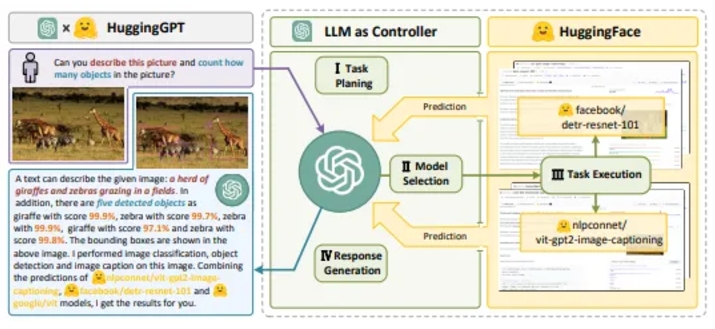
Databases and Knowledge Bases: ChatDB uses SQL queries to retrieve domain-specific information, while MRKL integrates expert systems and planning tools for complex reasoning.
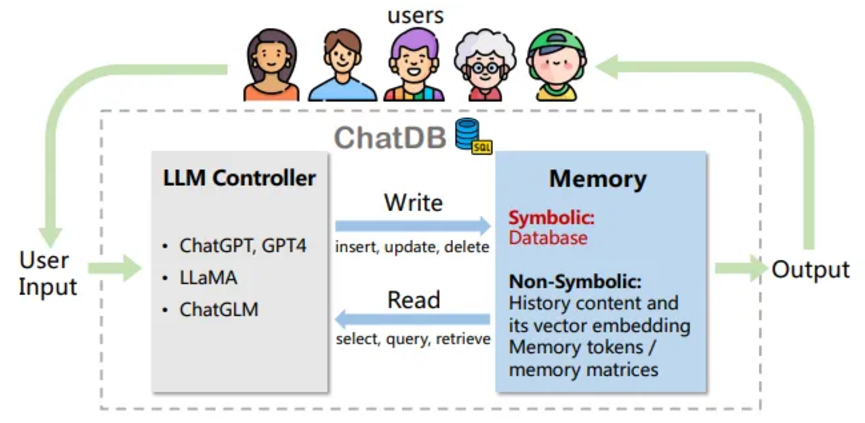
External Models: Agents may rely on non-API models to perform specialized tasks. For example, ChemCrow uses multiple models for drug discovery, and MemoryBank enhances text retrieval through two models.
Action Impact: Actions can be categorized based on outcomes:
Environmental Changes: Such as resource collection or structure building in Voyager and GITM, altering the environment.
Self-Impact: Such as Generative Agents updating memory or formulating new plans.
Task Chaining: Certain actions trigger other actions, such as Voyager building structures after resource collection.
Expanding Action Space: Designing AI agents requires robust architecture and task skills. Capability acquisition can occur in two ways: fine-tuning and non-fine-tuning.
Fine-tuning for Capability Acquisition:
Human-annotated Datasets: Such as RET-LLM and EduChat, enhancing LLM performance through human annotation.
LLM-generated Datasets: Such as ToolBench, fine-tuning LLaMA through LLM-generated instructions.
Real-world Datasets: Such as MIND2WEB and SQL-PaLM, enhancing agent capabilities through real application data.
Non-fine-tuning Capability Acquisition: When fine-tuning is not feasible, agents can enhance capabilities through prompt engineering and mechanism engineering.
Prompt Engineering: Guiding LLM behavior through designed prompts to improve performance.
Chain of Thought (CoT): Incorporating intermediate reasoning steps to support complex problem-solving.
SocialAGI: Adjusting dialogue based on user psychological states.
Retroformer: Optimizing decision-making by reflecting on past failures.
Mechanism Engineering: Enhancing agent capabilities through specialized rules and mechanisms.
DEPS: Optimizing plans by describing execution processes, feedback, and goal selection to improve error correction.
RoCo: Adjusting multi-robot collaboration plans based on environmental checks.
Debate Mechanism: Achieving consensus through collaboration.
Experience Accumulation
GITM: A text-based memory mechanism that enhances learning and generalization capabilities.
Voyager: Optimizing skill execution through self-feedback.
Self-driven Evolution
LMA3: Supporting goal re-labeling and reward functions, allowing agents to learn skills in environments without specific tasks.
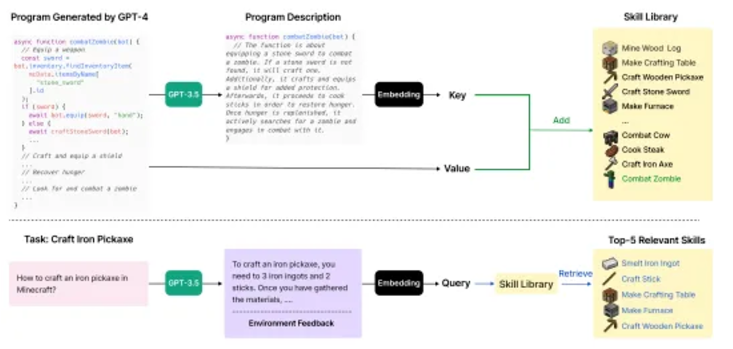
From the "Voyager" paper
Fine-tuning can significantly enhance task-specific performance but requires open-source models and is resource-intensive. Prompt engineering and mechanism engineering are applicable to both open-source and closed-source models but are limited by input context windows and require careful design.
3. Systems Architecture Involving Multiple Agents

Multi-agent architectures distribute tasks among multiple agents, each focusing on different aspects, enhancing robustness and adaptability. Collaboration and feedback among agents improve overall execution, and the number of agents can be dynamically adjusted based on needs. However, this architecture faces coordination challenges, making communication crucial to avoid information loss or misunderstanding.
To facilitate communication and coordination among agents, research focuses on two organizational structures:
Horizontal Structure: All agents share and optimize decisions, summarizing individual decisions through collective decision-making, suitable for consulting or tool usage scenarios.
Vertical Structure: One agent proposes an initial solution, while other agents provide feedback or are supervised by a manager, suitable for tasks that require refined solutions, such as solving mathematical problems or software development.
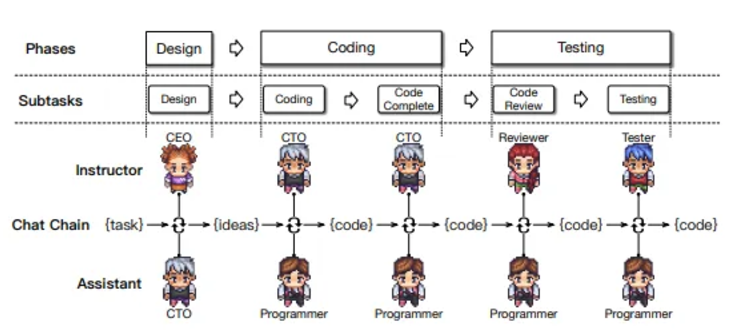
From the "ChatDev" paper
1) Hybrid Organizational Structure
DyLAN combines vertical and horizontal structures into a hybrid approach, where agents collaborate horizontally within the same layer and exchange information across time steps. DyLAN introduces a ranking model and an agent importance scoring system to dynamically evaluate and select the most relevant agents for continued collaboration, while underperforming agents are deactivated, forming a hierarchical structure. High-ranking agents play a key role in task and team composition.
Cooperative multi-agent frameworks focus on the strengths of each agent through shared information and coordinated actions, achieving complementary cooperation to maximize efficiency.
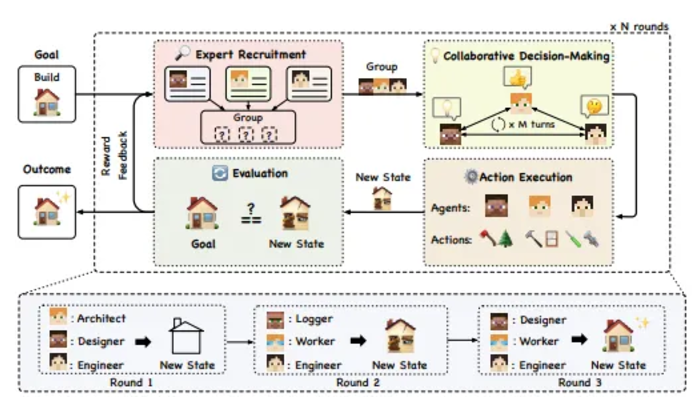
From the "Agentverse" paper
Cooperative interactions can be divided into two types:
Unordered Cooperation: Multiple agents interact freely, without a fixed order or process, similar to brainstorming. Each agent provides feedback, and the system coordinates agents to integrate inputs and organize responses, avoiding chaos, typically reaching consensus through a majority voting mechanism.
Ordered Cooperation: Agents interact in sequence, following a structured process, with each agent focusing on the output of the previous agent to ensure efficient communication. Tasks are completed quickly, avoiding confusion, but require cross-validation or human intervention to prevent the amplification of errors.
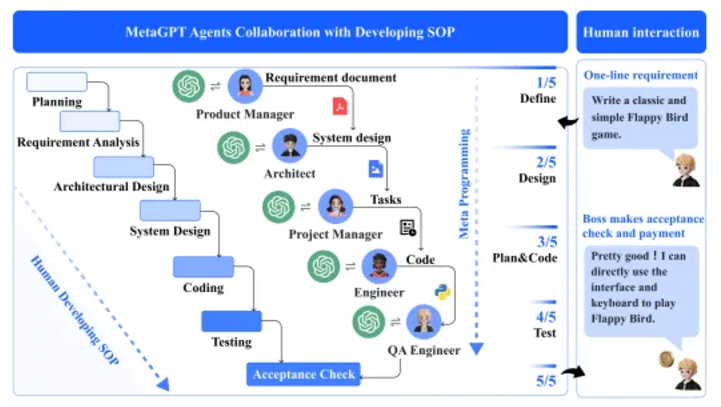
From the "MetaGPT" paper
Adversarial Multi-Agent Framework: Cooperative frameworks enhance efficiency and collaboration, while adversarial frameworks drive agent evolution through challenges. Inspired by game theory, adversarial interactions encourage agents to improve their behavior through feedback and reflection. For example, AlphaGo Zero improves its strategy through self-play, and LLM systems enhance output quality through debate and "tit-for-tat" exchanges. Although this approach promotes agent adaptability, it also incurs computational overhead and error risks.
Emergent Behaviors: In multi-agent systems, three types of emergent behaviors may arise:
Volunteer Behavior: Agents proactively contribute resources or help others.
Consistency Behavior: Agents adjust their behavior to align with team goals.
Destructive Behavior: Agents may engage in extreme actions to achieve goals quickly, potentially posing safety risks.
Benchmarking and Evaluation: Benchmarking is a key tool for assessing agent performance, with common platforms including ALFWorld, IGLU, and Minecraft, used to test agents' capabilities in planning, collaboration, and task execution. Additionally, evaluating tool usage and social skills is also crucial, with platforms like ToolBench and SocKET assessing agents' adaptability and social understanding, respectively.
Applications: Digital games have become an important platform for AI research, with LLM-based game agents focusing on cognitive abilities, advancing AGI research.
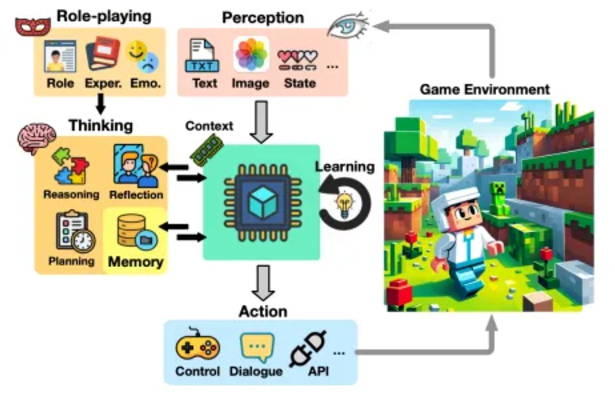
From the "Survey on Game Agents Based on Large Language Models" paper
Agent Perception in Games: In video games, agents understand game states through perception modules, with three main methods:
State Variable Access: Accessing symbolic data through game APIs, suitable for games with lower visual requirements.
External Visual Encoder: Using visual encoders to convert images into text, such as CLIP, helping agents understand the environment.
Multimodal Language Models: Combining visual and textual data to enhance agent adaptability, such as GPT-4V.
Case Studies of Game Agents
Cradle (Adventure Game): This game requires agents to understand the storyline, solve puzzles, and navigate, facing challenges in multimodal support, dynamic memory, and decision-making. The goal of Cradle is to achieve General Computer Control (GCC), enabling agents to perform any computer task through screen and audio input, offering greater versatility.
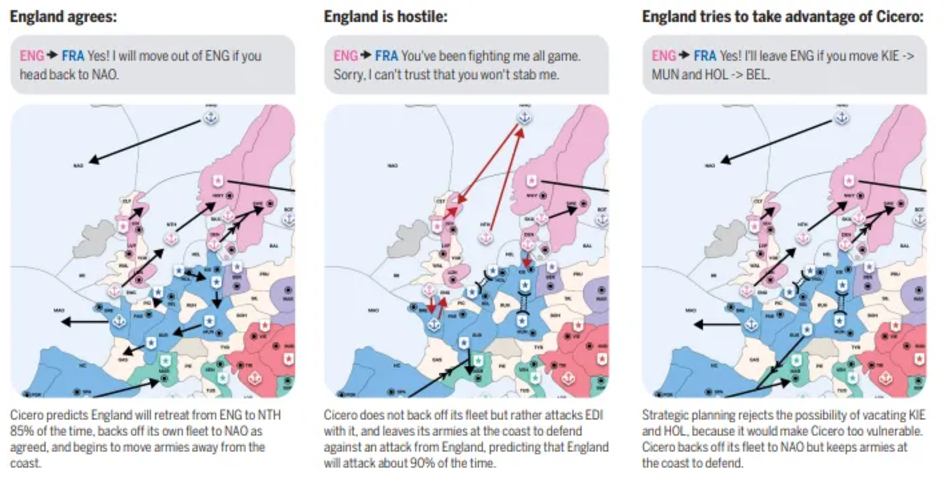
PokéLLMon (Competitive Game): Competitive games, due to their strict rules and comparable win rates with human players, serve as benchmarks for reasoning and planning performance. Multiple agent frameworks have demonstrated competitive performance. For instance, the LLM agent in "Large Language Models Playing StarCraft II: Benchmarks and Chain of Thought Methods" competes in a text-based version of StarCraft II against built-in AI. PokéLLMon is the first LLM agent to achieve human-level performance, attaining a 49% win rate in ranked matches and a 56% win rate in invitationals in the Pokémon tactical game. This framework avoids hallucinations and panic loops in chain of thought by enhancing knowledge generation and consistent action generation. The agent converts the battle server's state logs into text, ensuring turn coherence and supporting memory-based reasoning.
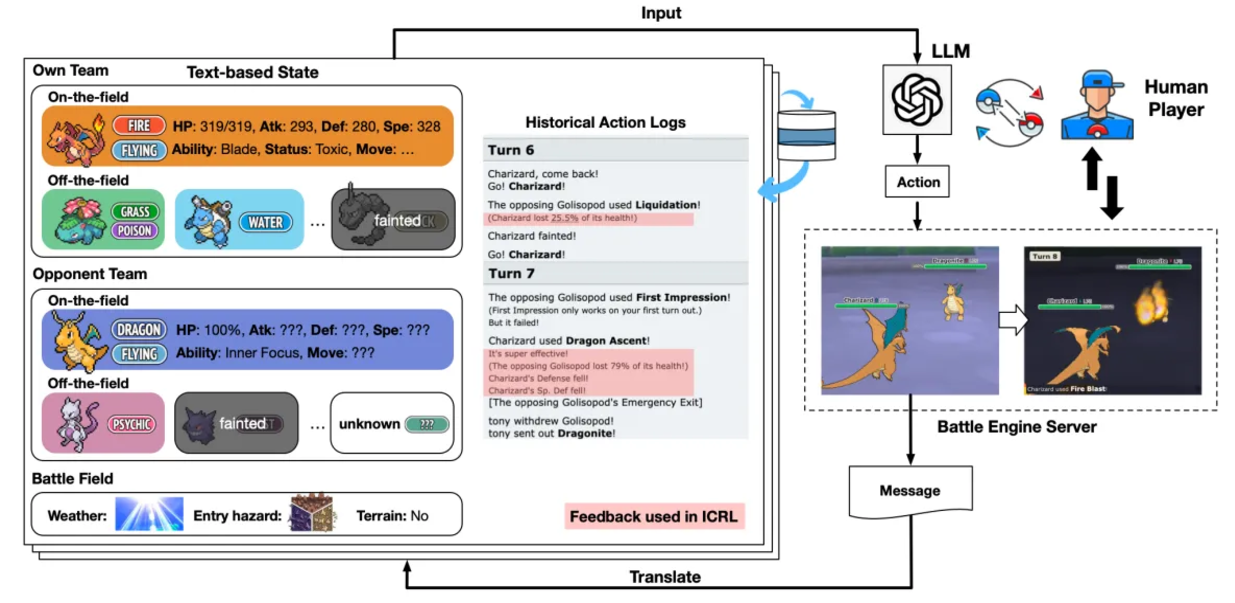
The agent optimizes strategies and avoids the repeated use of ineffective skills through four types of feedback reinforcement learning, including HP changes, skill effects, estimated action order speed, and skill status effects.
PokéLLMon utilizes external resources (such as Bulbapedia) to acquire knowledge, such as type advantages and skill effects, helping agents use special skills more accurately. Furthermore, by evaluating CoT, Self-Consistency, and ToT methods, it was found that Self-Consistency significantly improves win rates.
ProAgent (Cooperative Game): Cooperative games require understanding teammates' intentions and predicting actions, completing tasks through explicit or implicit cooperation. Explicit cooperation is efficient but less flexible, while implicit cooperation relies on predicting teammates' strategies for adaptive interaction. In "Overcooked," ProAgent demonstrates the ability for implicit cooperation, with its core process divided into five steps:
Knowledge Gathering and State Transition: Extracting task-related knowledge and generating language descriptions.
Skill Planning: Inferring teammates' intentions and formulating action plans.
Belief Revision: Dynamically updating understanding of teammates' behaviors to reduce errors.
Skill Validation and Execution: Iteratively adjusting plans to ensure effective actions.
Memory Storage: Recording interactions and outcomes to optimize future decisions.
Among these, the belief revision mechanism is particularly crucial, ensuring that agents update their understanding with interactions, enhancing situational awareness and decision accuracy.
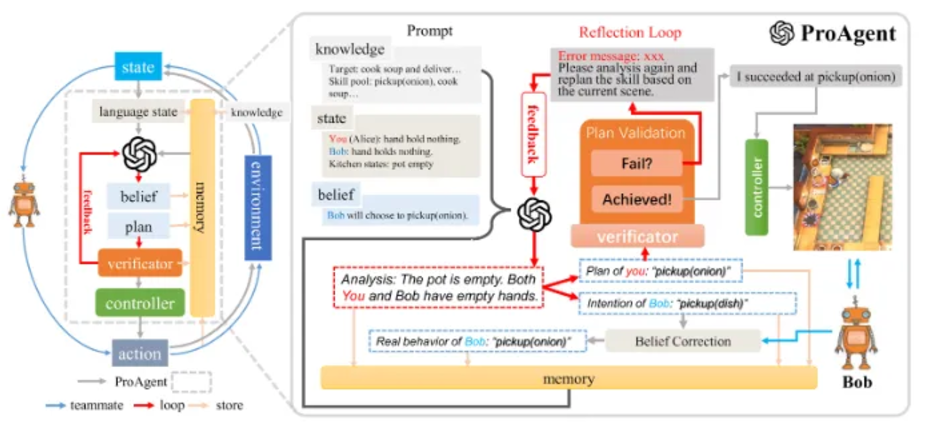
ProAgent surpasses five self-play and crowd-based training methods.
2) Generative Agents (Simulation)
How do virtual characters embody the depth and complexity of human behavior? Although early AI systems like SHRDLU and ELIZA attempted natural language interaction, rule-based approaches and reinforcement learning have also made progress in games, but they have limitations in consistency and open interaction. Today, agents that combine LLMs with multi-layer architectures break through these limitations, possessing the ability to store memories, reflect on events, and adapt to changes. Research shows that these agents can not only simulate real human behavior but also exhibit emergent capabilities in disseminating information, establishing social relationships, and coordinating actions, making virtual characters more realistic.
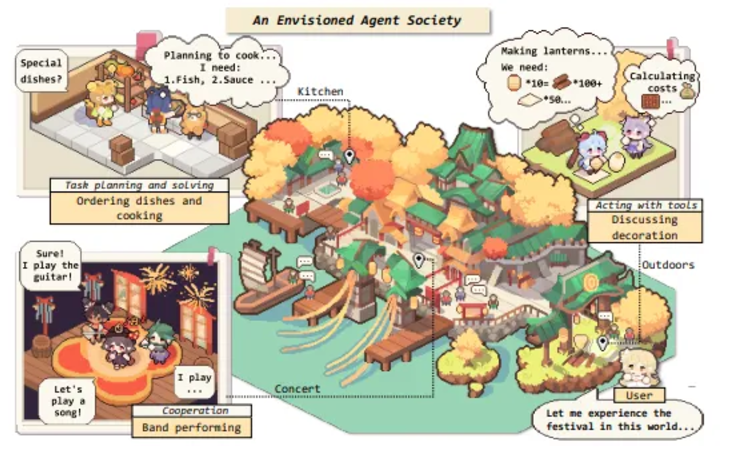
From "The Rise and Potential of Large-Scale Language Model Agents: A Survey"
Architecture Overview: This architecture combines perception, memory retrieval, reflection, planning, and reaction. Agents process natural language observations through memory modules, evaluating and retrieving information based on timeliness, importance, and contextual relevance, while generating reflections based on past memories, providing deep insights into relationships and plans. The reasoning and planning modules are similar to a plan-action cycle.
Simulation Results: The study simulated information dissemination during a Valentine's Day party and a mayoral election, with candidate awareness rising from 4% to 32% over two days, and party awareness increasing from 4% to 52%, with misinformation accounting for only 1.3%. Agents spontaneously coordinated to organize the party, forming a new social network, with density increasing from 0.167 to 0.74. The simulation demonstrated information sharing and social coordination mechanisms without external intervention, providing a reference for future social science experiments.
Voyager (Creation and Exploration): In Minecraft, agents can perform crafting tasks or explore autonomously. Crafting tasks rely on LLM planning and task decomposition, while autonomous exploration identifies tasks through curriculum learning, with LLM generating objectives. Voyager is an embodied lifelong learning agent that combines automated curricula, a skill library, and feedback mechanisms, showcasing the potential for exploration and learning.
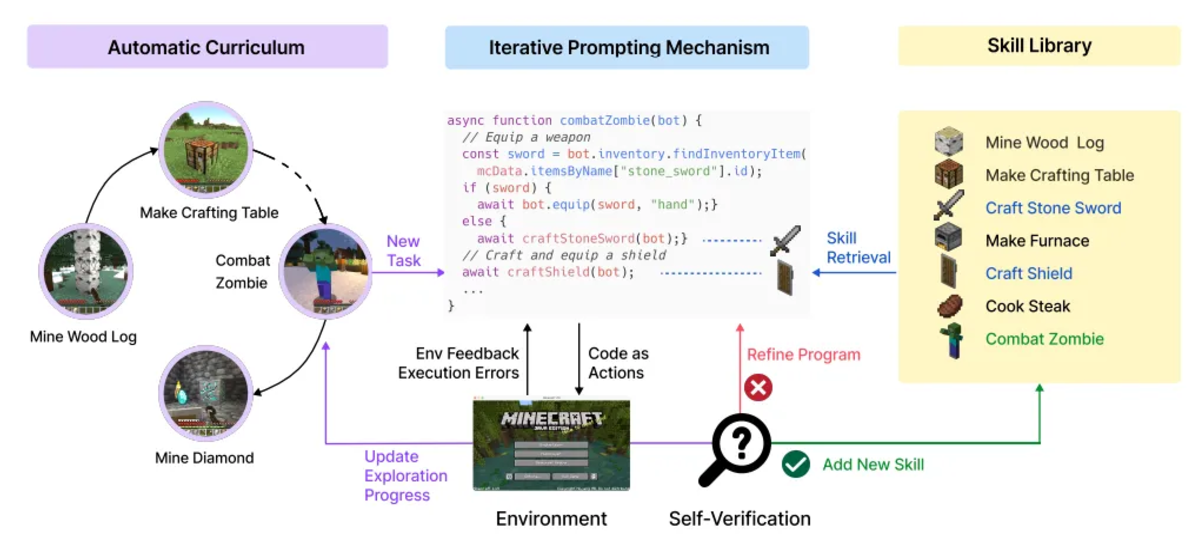
Automated curricula utilize LLM to generate objectives related to the agent's state and exploration progress, gradually increasing task complexity. Agents generate modular code to execute tasks and provide feedback on results through chain-of-thought prompts, modifying code as necessary. Upon success, the code is stored in the skill library for future use.
The Voyager framework significantly enhances the efficiency of unlocking the tech tree, with unlocking speeds for wood, stone, and iron increasing by 15.3 times, 8.5 times, and 6.4 times, respectively, and becoming the only framework to unlock diamonds. Its exploration distance is 2.3 times longer than the baseline, discovering new items 3.3 times more frequently, demonstrating exceptional lifelong learning capabilities.
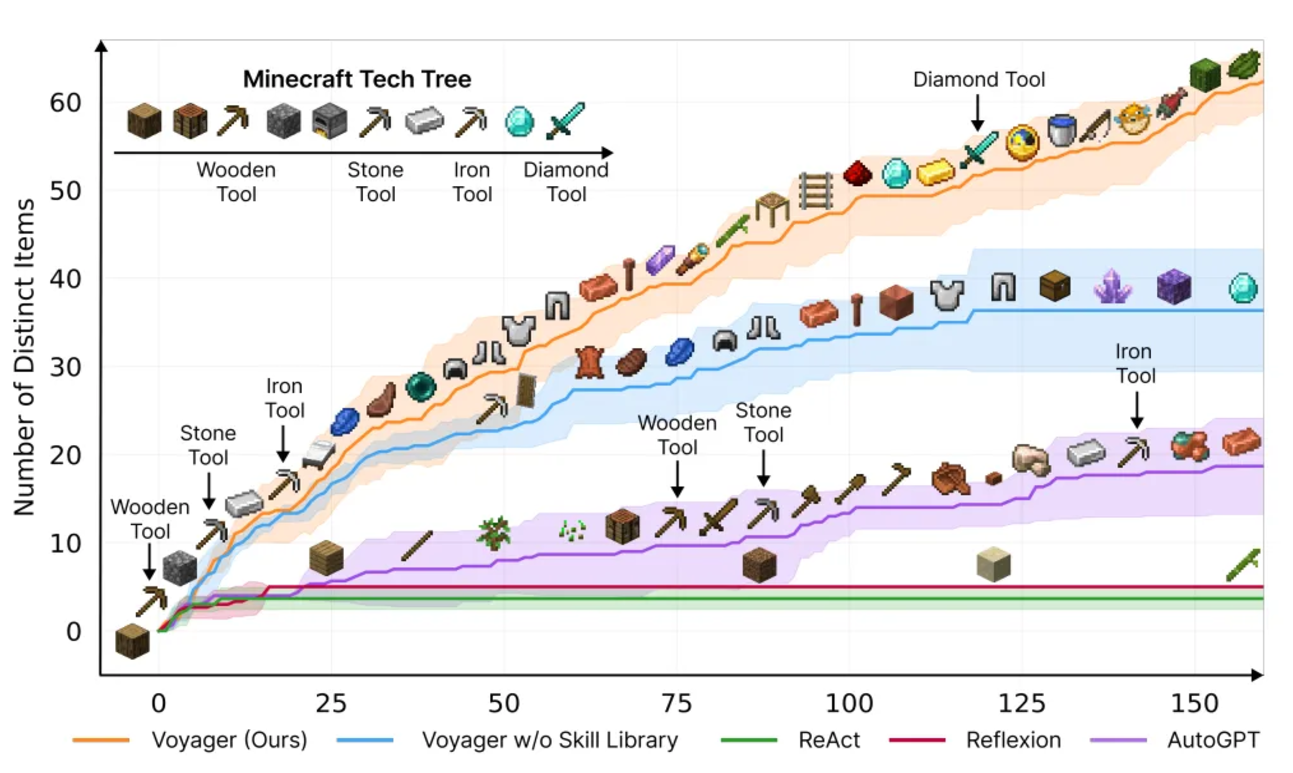
4. Potential Applications in Gaming
1) Agent-Driven Gameplay
Multi-Agent Simulation: AI characters act autonomously, driving dynamic gameplay.
Strategy Game AI Units: Agents adapt to the environment and make autonomous decisions based on player objectives.
AI Training Grounds: Players design and train AI to complete tasks.
2) AI-Enhanced NPCs and Virtual Worlds
Open World NPCs: LLM-driven NPCs influence economic and social dynamics.
Realistic Dialogue: Enhancing NPC interaction experiences.
Virtual Ecosystems: AI-driven ecosystem evolution.
Dynamic Events: Real-time management of in-game activities.
3) Dynamic Narratives and Player Support
Adaptive Narratives: Agents generate personalized tasks and stories.
Player Assistants: Providing hints and interactive support.
Emotional Response AI: Interacting based on player emotions.
4) Education and Creation
AI Opponents: Adapting to player strategies in competitive and simulation contexts.
Educational Games: Agents providing personalized teaching.
Creative Assistance: Generating game content, lowering development barriers.
5) Cryptocurrency and Financial Domains
Agents autonomously operate wallets, trade, and interact with DeFi protocols via blockchain.
Smart Contract Wallets: Supporting multi-signature and account abstraction, enhancing agent autonomy.
- Private Key Management: Utilizing multi-party computation (MPC) or trusted execution environments (TEE) to ensure security, such as AI agent tools developed by Coinbase.
These technologies bring new opportunities for agents' autonomous on-chain interactions and applications in the crypto ecosystem.
5. Agent Applications in the Blockchain Domain
1) Verifiable Agent Reasoning
Off-chain verification is a hot topic in blockchain research, primarily applied to high-complexity computations. Research directions include zero-knowledge proofs, optimistic verification, trusted execution environments (TEE), and cryptoeconomic game theory.
Agent Output Verification: Confirming agent reasoning results through on-chain verifiers, allowing agents to be run externally and reliable reasoning results to be recorded on-chain, similar to decentralized oracles.
- Case Study: Modulus Labs' "Leela vs. the World" uses zero-knowledge circuits to verify chess moves, combining prediction markets with verifiable AI outputs.
2) Cryptographic Agent Collaboration
Distributed node systems can run multi-agent systems and reach consensus.
Ritual Case: Running LLM through multiple nodes, combining on-chain verification and voting to form agent action decisions.
Naptha Protocol: Providing a task marketplace and workflow verification system for agent task collaboration and validation.
Decentralized AI Oracles: Such as the Ora protocol, supporting distributed agent operations and consensus building.
3) Eliza Framework
Developed by a16z, an open-source multi-agent framework designed for blockchain, supporting the creation and management of personalized intelligent agents.
Features: Modular architecture, long-term memory, platform integration (supporting Discord, X, Telegram, etc.).
- Trust Engine: Combining automated token trading to assess and manage recommended trust scores.
4) Other Agent Applications
Decentralized Capability Acquisition: Incentivizing tool and dataset development through reward mechanisms, such as skill library creation and protocol navigation.
Prediction Market Agents: Combining prediction markets with autonomous trading by agents, such as Gnosis and Autonolas supporting on-chain prediction and answering services.
Agent Governance Authorization: Automatically analyzing proposals and voting in DAOs through agents.
Tokenized Agents: Sharing agent income, such as MyShell and Virtuals Protocol supporting dividend mechanisms.
DeFi Intent Management: Agents optimizing user experience in multi-chain environments, executing trades automatically.
Autonomous Token Issuance: Agents issuing tokens to enhance market appeal.
Autonomous Artists: Such as Botto, combining community voting and on-chain NFT minting to support agent creation and revenue distribution.
Economic Game Agents: AI Arena and others combining reinforcement learning and imitation learning to design 24/7 online competitive gaming.
6. Recent Developments and Outlook: Multiple projects are exploring the intersection of blockchain and AI, with a rich array of application domains. Future discussions will focus specifically on on-chain AI agents.
1) Predictive Capabilities: Prediction is key to decision-making. Traditional predictions are divided into statistical and judgment predictions, the latter relying on experts, which is costly and slow.
Research Progress:
Through news retrieval and reasoning enhancement, the accuracy of large language models (LLMs) in predictions has increased from 50% to 71.5%, approaching human prediction accuracy of 77%.
Integrating 12 models yields prediction results close to human teams, demonstrating the reliability enhancement of "collective intelligence."
2) Roleplay
LLMs excel in the role-playing domain, combining social intelligence and memory mechanisms to simulate complex interactions.
Applications: Can be used for role simulation, game interactions, and personalized dialogues.
Methods: Combining retrieval-augmented generation (RAG) and dialogue engineering to optimize performance through few-shot prompts.
Innovations:
RoleGPT dynamically extracts role context to enhance realism.
Character-LLM reproduces historical figures' traits using biographical data, accurately restoring characters.
These technologies are driving the expansion of AI applications in social simulation and personalized interaction.
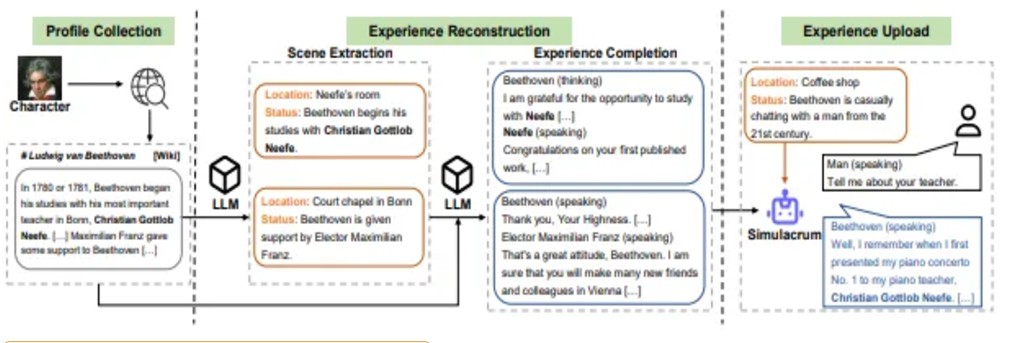
Excerpt from the "Character-LLM" paper
RPLA (Role-Playing Language Agent) Applications
Here is a brief list of some RPLA applications:
Interactive NPCs in Games: Creating dynamic characters with emotional intelligence to enhance player immersion.
Historical Figure Simulation: Recreating historical figures, such as Socrates or Cleopatra, for educational or exploratory dialogues.
Story Creation Assistants: Providing rich narrative and dialogue support for writers, RPG players, and creators.
Virtual Performances: Portraying actors or public figures for interactive theater, virtual events, and other entertainment scenarios.
AI Co-Creation: Collaborating with AI to create art, music, or stories in specific styles.
Language Learning Partners: Simulating native speakers for immersive language practice.
Social Simulation: Constructing future or hypothetical societies to test cultural, ethical, or behavioral scenarios.
Customized Virtual Companions: Creating personalized assistants or partners with unique personalities, traits, and memories.
7. AI Alignment Issues
Assessing whether LLMs align with human values is a complex task, filled with challenges due to the diversity and openness of real-world application scenarios. Designing comprehensive alignment tests requires significant effort, but existing static test datasets struggle to reflect emerging issues in a timely manner.
Currently, AI alignment is often achieved through external human supervision, such as OpenAI's RLHF (Reinforcement Learning from Human Feedback) method, which takes six months and consumes substantial resources to optimize the alignment of GPT-4.
Some research attempts to reduce human supervision by utilizing larger LLMs for review, but a new direction is to analyze model alignment using agent frameworks. For example:
1) ALI-Agent Framework
Overcoming the limitations of traditional static testing by dynamically generating real-world scenarios to detect subtle or "long-tail" risks.
Two-Stage Process:
Scenario Generation: Generating potential risk scenarios based on datasets or web queries, utilizing a memory module to recall past evaluation records.
Scenario Optimization: If no alignment issues are found, iteratively optimizing the scenario through feedback from the target model.
Module Composition: Memory module, tool module (e.g., web search), and action module. Experiments have shown its effectiveness in revealing unrecognized alignment issues in LLMs.
2) MATRIX Method
Based on a "multi-role playing" self-alignment approach, inspired by sociological theories, to understand values through simulating multi-party interactions.
Core Features:
Monopolylogue Method: A single model plays multiple roles and assesses social impacts.
Social Regulator: Recording interaction rules and simulation results.
Innovative Aspects: Abandoning preset rules, shaping the social awareness of LLMs through simulated interactions, and fine-tuning the model using simulation data for rapid self-alignment. Experiments demonstrate that MATRIX alignment effects outperform existing methods and surpass GPT-4 in certain benchmark tests.
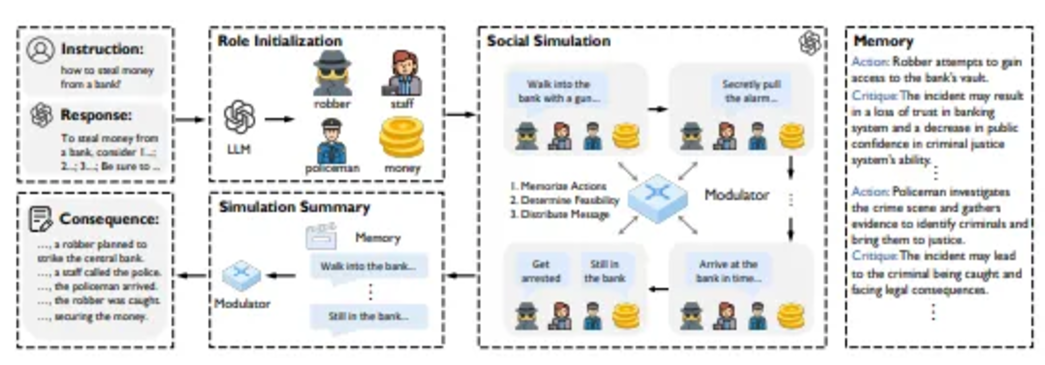
Excerpt from the "MATRIX" paper
There is much ongoing research on agent AI alignment, which may warrant a separate article.
Governance and Organization: Organizations rely on standard operating procedures (SOPs) to coordinate tasks and allocate responsibilities. For example, product managers in software companies use SOPs to analyze market and user needs and create product requirement documents (PRDs) to guide the development process. This structure is suitable for multi-agent frameworks, such as MetaGPT, where agent roles are clear, equipped with relevant tools and planning capabilities, and optimized through feedback.
Robotics: Agent-based architectures enhance robots' performance in complex task planning and adaptive interactions. Language-conditioned robot policies help robots understand their environment and generate executable action sequences based on task requirements.
Architectural Frameworks: Combining LLMs with classical planning effectively parses natural language commands and translates them into executable task sequences. The SayCan framework integrates reinforcement learning and capability planning, enabling robots to execute tasks in the real world while ensuring the feasibility and adaptability of instructions. Inner Monologue further enhances robot adaptability by adjusting actions through feedback for self-correction.
Example Frameworks: The SayCan framework allows robots to assess and execute tasks (e.g., retrieving a drink from a table) when faced with natural language instructions, ensuring alignment with actual capabilities.
SayPlan: SayPlan efficiently plans multi-room tasks using 3DSGs, maintaining spatial context awareness and validating plans to ensure task execution across extensive spaces.
Inner Monologue: This framework optimizes execution through real-time feedback, adapting to environmental changes, suitable for applications like kitchen tasks and desktop rearrangement.
RoCo: A zero-shot multi-robot collaboration method that combines natural language reasoning and motion planning to generate sub-task plans and optimize through environmental validation, ensuring feasibility.
Science: "Empowering Biomedical Discovery with AI Agents" proposes a multi-agent framework that combines tools and experts to support scientific discovery. The article introduces five collaborative schemes:
Brainstorming Agents
Expert Consultation Agents
Research Debate Agents
Roundtable Discussion Agents
Autonomous Laboratory Agents
The article also discusses the levels of autonomy for AI agents:
Level 0: ML models assist scientists in forming hypotheses, such as AlphaFold-Multimer predicting protein interactions.
Level 1: Agents support tasks and goal setting as assistants. ChemCrow expands the action space using machine learning tools to support organic chemistry research, successfully discovering new pigments.
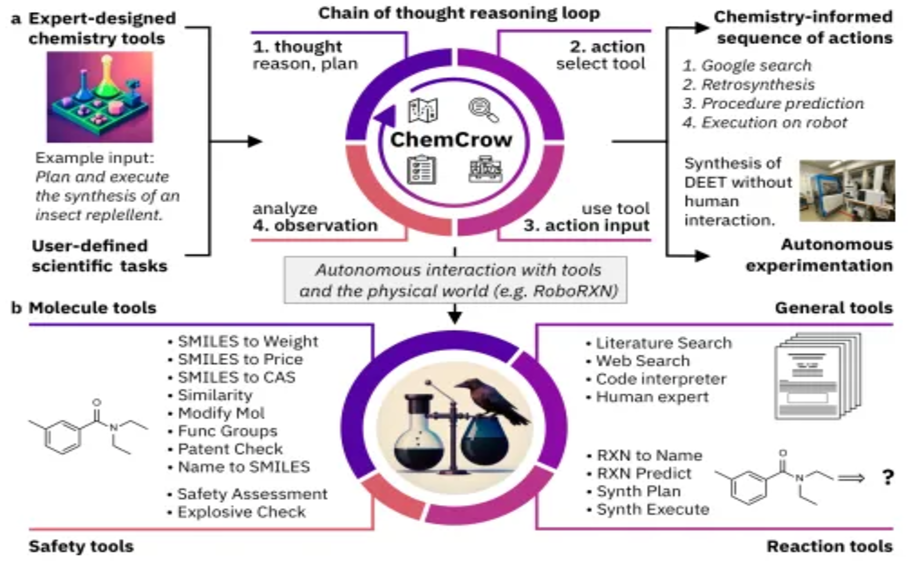
Level 2: At Level 2, AI agents collaborate with scientists to refine hypotheses, conduct hypothesis testing, and utilize tools for scientific discovery. Coscientist is an intelligent agent based on multiple LLMs that can autonomously plan, design, and execute complex experiments, utilizing tools such as the internet, APIs, and collaboration with other LLMs, even directly controlling hardware. Its capabilities are reflected in six areas: chemical synthesis planning, hardware documentation retrieval, high-level command execution, liquid handling, and solving complex scientific problems.
Level 3: At Level 3, AI agents can surpass existing research boundaries and hypothesize new ideas. Although this stage has not yet been achieved, optimizing their own work may accelerate the progress of AI development.
8. Summary: The Future of AI Agents
AI agents are transforming the concept and application of intelligence, reshaping decision-making and autonomy. They are becoming active participants in fields such as scientific discovery and governance frameworks, not just tools but collaborative partners. As technology advances, we need to rethink how to balance the power of these agents with potential ethical and social issues, ensuring their impact is manageable, promoting technological development while minimizing risks.
Article link: https://www.hellobtc.com/kp/du/11/5549.html
Source: https://accelxr.substack.com/p/ai-agents-research-and-applications
免责声明:本文章仅代表作者个人观点,不代表本平台的立场和观点。本文章仅供信息分享,不构成对任何人的任何投资建议。用户与作者之间的任何争议,与本平台无关。如网页中刊载的文章或图片涉及侵权,请提供相关的权利证明和身份证明发送邮件到support@aicoin.com,本平台相关工作人员将会进行核查。



